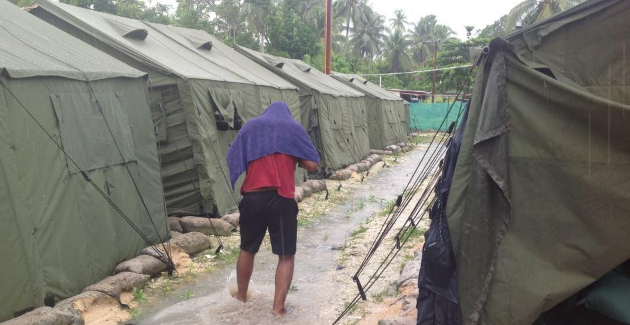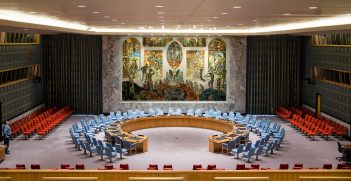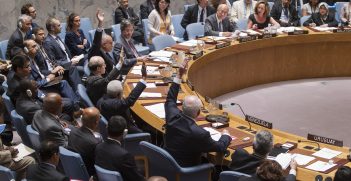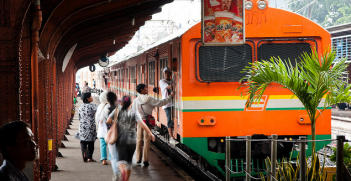Fragile Refugee Agreement Reveals the Real Policy Failure

Slow progress is being made on Australia’s refugee deal with the United States, but in recent weeks US officials have fingerprinted and photographed refugees on Nauru and Manus Island. The agreement shows Australia’s commitment to achieving a political outcome at the expense of developing a functional regional framework.
In March, a Senate committee heard surprising evidence from Australia’s Ambassador for People Smuggling and Human Trafficking. The Ambassador Andrew Goledzinowksi refuted statements that there was a limit on the number of refugees the United States may accept for resettlement from Nauru and Papua New Guinea. Instead, he explained the US could potentially take as many as 2000 refugees; or it could decide to take none.
However, the announcement by the United Nations High Commissioner for Refugees (UNHCR) that it would likely endorse only 850, may see the numbers sit closer to the original 1,250 announced by the Australian government last year.
Regardless of how many refugees are accepted by the US, ultimately, a key component of the Australian policy of offshore processing will have failed.
The policy to remove asylum seekers to Nauru and Manus Island was ostensibly introduced to disrupt people smuggling regimes. However, offshore processing was also a key component of a contentious suite of measures designed by the expert panel to develop an effective regional framework to address irregular migration in the region. The legislation that enacted that framework was supported by the Coalition along with the aims of the expert panel report. The initial arrangements between Australia and Nauru and PNG in 2012 were intended to provide a means of processing claims of refugees prior to regional resettlement.
In July 2013, the government signed an “additional arrangement” with PNG. In a formal admission that regional processing alone was not a solution, the arrangement included a statement that “the missing element in current regional processing arrangements involving Australia is the absence of a final destination for those proven to be refugees for permanent settlement”.
In 2013, new agreements were signed with both countries. These agreements explicitly referenced the Bali Process and the need to promote a regional response to the humanitarian and border protection issues created by people smuggling. The new agreements contained a commitment to resettle refugees, either on a permanent or temporary basis. Neither of these agreements, or the subsequent Cambodian and US agreements, contained fixed numbers on the resettlement places that each country would offer. Presumably then, these new agreements to grant residency to refugees met the original intent of parliament when it passed the legislation that reestablished regional processing. After all, Nauru and PNG are regional countries.
If we ignore the disastrous effect offshore processing has had on the lives of asylum seekers and the very real financial and human rights problems that have been associated with resettling refugees on Nauru and PNG, it is interesting to contemplate why Australia continues to determine where the refugees can be resettled. Australia’s commitment to achieving a political outcome at the expense of a developing a functional regional framework is at the centre of consecutive governments’ failures to find a regional solution for the ongoing humanitarian crisis in our region.
The chaperoning of decision-making surrounding resettlement was described by Ambassador Goledzinowski as a formal undertaking to the government of Nauru and an informal undertaking to PNG, “to support their efforts to find third country resettlement options”. Yet it remains a mystery why the governments of Nauru and PNG have allowed Australia to continue to pursue its own policy aims and interests at the expense of their political needs by vetoing any real regional solutions.
Since 2013 the Australian government has consistently refused New Zealand’s offer to resettle 300 refugees. In direct contrast to the ambassador’s statement that Australia would support efforts to find resettlement countries, Minister for Immigration Peter Dutton declared that the resettlement of refugees to another country is a decision for the Nauruan government.
In recognition of Australia’s role in creating and maintaining this farcical and tragic situation, New Zealand has steadfastly refused to negotiate a separate agreement with Nauru.
An effective regional response relies upon countries in the region actively seeking real solutions. Focusing on people smuggling alone does little to assist refugees or countries of transit. One clear solution is for the most capable countries to offer permanent settlement to asylum seekers from the region in a manner that would respond to the real need to provide asylum, disrupt criminal activities and prevent further tragedies.
During the committee hearing the ambassador was asked:
“What, if anything, is the Australian government doing to engage with the UNHCR to help fund more rapid assessment of refugee status in Southeast Asia and what, if anything, is the Australian government doing to engage with the governments of Indonesia and Malaysia to better support displaced people in those countries?”
It should not be a hard question for the ambassador to answer. As a policy diplomat he would be all too familiar with the ongoing tense relationship between Australia and Papua New Guinea, following PNG’s High Court decision to close the centre on Manus Island. He would be very aware of the criticism of the Bali Process and of Australia for its lacking response to the Rohingya crisis in 2015 and our continued refusal to accept UNHCR-registered refugees from Indonesia under our humanitarian program.
After all, according to the DFAT website, Ambassador Goledzinowski
“…works closely with the Operation Sovereign Borders (OSB) Joint Agency Task Force, to ensure that international elements of OSB, including deterrence and resettlement, are effectively coordinated across government. He also leads Australia’s international engagement to help address human trafficking and slavery, and is co-chair of the 45-country regional grouping known as the Bali Process.”
The fact that he had to take this question on notice despite his role reveals Australia’s failure to seriously address the critical humanitarian issues driving irregular migration in our region.
Marianne Dickie is a senior lecturer in the Migration Law Program at the Australian National University (ANU) College of Law. Marianne is a general editor of the Immigration Review, published by LexisNexis.
This article is published under a Creative Commons Licence and may be republished with attribution.





